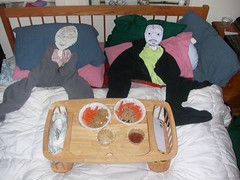I positively delight in fortuity. I’ve done some of my best, most productive research by wandering aimlessly around library stacks, gazing absently at book covers, pulling down peculiar titles or examining works that produce improbable combinations of authors and topics. I miss the liberty to stroll, to meander intellectually, more than almost any other cost of my furious busy-ness.
So it came as a stupendous delight to me that, at the recent SBL meeting, I had the chance to browse through a recent number of New Blackfriars, a journal to which I subscribed back in the days when it was a simply-produced, desktop-published bimonthly without the backing of any corporate megapublishers. Nowadays, under the umbrella of Blackwell, it has more professional production values, and I’m sure it costs more, but they still publish articles that tickle my theological synapses, and I relish each opportunity to read it.
At the meeting, I read along in the sample issue until I hit an article that captivated me: “Some Liturgical Implications of the Thought of David Jones,” by Christopher C. Knight (New Blackfriars 85 (998), 444-453). The title sounds pedestrian enough, but what knocked me out were the following paragraphs:
When some of [his essays] were collected together, in a volume entitled Epoch and Artist, its editor, Harman Grisewood, chose to put on the title page an unattributed quotation: “He placed himself in the order of signs.” It was an entirely appropriate quotation, for this was precisely what Jones had done throughout his adult life, both as artist-poet and as Christian. In Jones’ view, it was the sign-making nature of the human condition that made possible both human creativity and the sacramental understanding that was central to his faith.
The quotation chosen by Grisewood was not, however, one that had originally referred to any artist or poet in the usual sense. It was in fact from the work of the theologian, Maurice de la Taille, and it referred to Christ himself. What de la Taille had meant when he talked about “the order of signs” — in relation to the intrinsic link between the last supper, the cross, and the anamnesis of the eucharist— became a central aspect of Jones’ understanding. For, as Jones noted in his essay, Art and Sacrament, de la Taille’s thinking had “shed a sort of reflected radiance on the sign world in general.”
Oh, baby! “He placed himself in the order of signs.” How cool is that? It immediately became a vital point of reference for the lecture I’m working on for next spring.
Better yet, when I got home to Seabury and investigated our holdings of Jones’s works, I found that Seabury owns one of a scant 350 copies of Jones’s essay, “Use & Sign” (Ipswich: Golgonooza Press, 1975; ours is hand-numbered copy 342). The short essay hits several points I will surely cite later, but it pleases me especially because its style reminds me of one of my favorite authors.
When Mary Maudlin fractured the alabaster of nard over the feet of the hero of the Christian cult, Sir Mordred at the dinner party asked: ‘To what purpose is this waste?’ But the cult-hero himself said: ‘Let her alone. What she does is for a presignification of my death, and wherever my saga is sung in the whole universal world, this sign-making of hers shall be sung also, for a memorial of her.’ A totally inutile act, but a two-fold anamnesis (that is, a double and effectual re-telling). First of the hero Himself and then of the mistress of all contemplatives and the tutelary figure of all that belongs to poiesis. The woman from Magdala in her golden hair, wasting her own time and the party funds: an embarrassment if not a scandal; but an act which is of the very essence of all poetry and, by the same token, of any religion worth consideration.
The notes of that rhetorical melody remind me of Tom’s writing, and the rhythms and harmonies of the Tutor’s gilded lash. As I draw on Jones in preparing my lecture, I’ll be hearing my friends — which will make my preparations all the more satisfying, and which can only strengthen, enrich the result.
